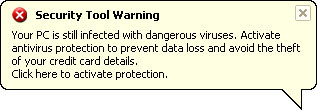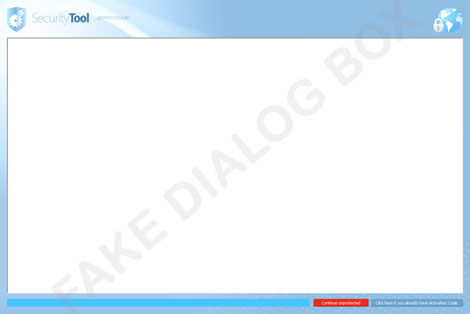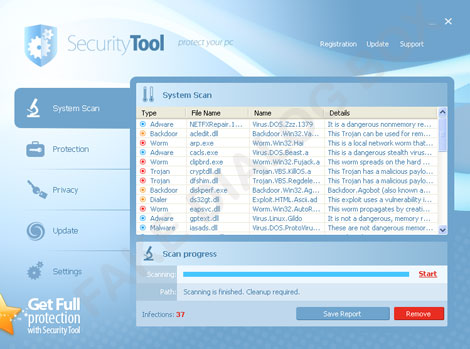TROJ_WINWEBSE.AU
Trojan:Win32/Winwebsec(Microsoft), FakeAlert-KW.m(McAfee)
Windows 2000, Windows Server 2003, Windows XP (32-bit, 64-bit), Windows Vista (32-bit, 64-bit), Windows 7 (32-bit, 64-bit)


Threat Type: Trojan
Destructiveness: No
Encrypted: Yes
In the wild: Yes
OVERVIEW
Dropped by other malware, Downloaded from the Internet
This Trojan arrives on a system as a file dropped by other malware or as a file downloaded unknowingly by users when visiting malicious sites.
It deletes itself after execution.
When users agree to buy the software, it connects to a certain URL. It displays a window where users can purchase this fake antivirus program.
TECHNICAL DETAILS
832,001 bytes
EXE
Yes
03 Jun 2013
Displays fake images, Connects to URLs/IPs, Compromises system security
Arrival Details
This Trojan arrives on a system as a file dropped by other malware or as a file downloaded unknowingly by users when visiting malicious sites.
Installation
This Trojan drops the following file(s)/component(s):
- %Desktop%\Security Tool.lnk
- %Start Menu%\Programs\Security Tool.lnk
- %All Users Profile%\{random folder name}\{random filename}.bat
(Note: %Desktop% is the current user's desktop, which is usually C:\Documents and Settings\{User Name}\Desktop on Windows 2000, XP, and Server 2003, or C:\Users\{user name}\Desktop on Windows Vista and 7.. %Start Menu% is the current user's Start Menu folder, which is usually C:\Windows\Start Menu or C:\Documents and Settings\{User name}\Start Menu on Windows 2000, XP, and Server 2003, or C:\Users\{user name}\AppData\Roaming\Microsoft\Windows\Start Menu on Windows Vista and 7.. %All Users Profile% is the All Users or Common profile folder, which is C:\Documents and Settings\All Users in Windows 2000, XP, and Server 2003, and C:\ProgramData in Windows Vista and 7.)
It drops the following copies of itself into the affected system:
- %All Users Profile%\Application Data\{random folder name}\{random filename}.exe (For Windows XP)
- %All Users Profile%\{random folder name}\{random filename}.exe (For Windows Vista and 7)
- %System Root%\Users\All Users\{random folder name}\{random filename}.exe (For Windows Vista and 7)
(Note: %All Users Profile% is the All Users or Common profile folder, which is C:\Documents and Settings\All Users in Windows 2000, XP, and Server 2003, and C:\ProgramData in Windows Vista and 7.. %System Root% is the root folder, which is usually C:\. It is also where the operating system is located.)
It creates the following folders:
- %All Users Profile%\Application Data\{random folder name} (For Windows XP)
- %All Users Profile%\{random folder name} (For Windows Vista and 7)
- %System Root%\Users\All Users\{random folder name} (For Windows Vista and 7)
(Note: %All Users Profile% is the All Users or Common profile folder, which is C:\Documents and Settings\All Users in Windows 2000, XP, and Server 2003, and C:\ProgramData in Windows Vista and 7.. %System Root% is the root folder, which is usually C:\. It is also where the operating system is located.)
Autostart Technique
This Trojan adds the following registry entries to enable its automatic execution at every system startup:
HKEY_LOCAL_MACHINE\Software\Microsoft\
Windows\CurrentVersion\Run
{random name} = "%All Users Profile%\{random folder name}\{random filename}.exe" (For Windows Vista and Windows 7)
HKEY_LOCAL_MACHINE\Software\Microsoft\
Windows\CurrentVersion\Run
{random name} = "%All Users Profile%\Application Data\{random folder name}\{random filename}.exe" (For Windows XP)
Other System Modifications
This Trojan adds the following registry keys:
HKEY_LOCAL_MACHINE\SOFTWARE\{random digit}
It adds the following registry entries:
HKEY_LOCAL_MACHINE\SOFTWARE\{random digit}
Grep = “{random value}”
Other Details
This Trojan deletes itself after execution.
Rogue Antivirus Routine
This Trojan displays the following fake alerts:
When users agree to buy the software, it connects to the following URL to continue the purchase:
- http://{BLOCKED}.{BLOCKED}.211.6/buy2.php?affid={value}&sts={value}
- http://{BLOCKED}d.{BLOCKED}f.yt:443
- http://{BLOCKED}.{BLOCKED}.65.204/buy2.php?affid={value}&sts={value}
The following window is displayed for users to purchase the fake antivirus program:
It displays the following window and pretends to scan the system:
NOTES:
Upon execution, this malware connects to the following website to send information:
- http://{BLOCKED}.{BLOCKED}.60.126/set.php?url={value}&affid={value}&sts={value}&win={OS Version}
SOLUTION
9.300
7.278.12
01 Jul 2010
7.279.00
02 Jul 2010
Step 1
Before doing any scans, Windows XP, Windows Vista, and Windows 7 users must disable System Restore to allow full scanning of their computers.
Step 2
Restart in Safe Mode
Step 3
Delete this registry key
Important: Editing the Windows Registry incorrectly can lead to irreversible system malfunction. Please do this step only if you know how or you can ask assistance from your system administrator. Else, check this Microsoft article first before modifying your computer's registry.
- In HKEY_LOCAL_MACHINE\SOFTWARE
- {random digit}
- {random digit}
Step 4
Delete this registry value
Important: Editing the Windows Registry incorrectly can lead to irreversible system malfunction. Please do this step only if you know how or you can ask assistance from your system administrator. Else, check this Microsoft article first before modifying your computer's registry.
- In HKEY_LOCAL_MACHINE\Software\Microsoft\Windows\CurrentVersion\Run
- {random name} = "%All Users Profile%\{random folder name}\{random filename}.exe"
- {random name} = "%All Users Profile%\{random folder name}\{random filename}.exe"
- In HKEY_LOCAL_MACHINE\Software\Microsoft\Windows\CurrentVersion\Run
- {random name} = "%All Users Profile%\Application Data\{random folder name}\{random filename}.exe"
- {random name} = "%All Users Profile%\Application Data\{random folder name}\{random filename}.exe"
Step 5
Search and delete these folders
- %All Users Profile%\Application Data\{random folder name}
- %All Users Profile%\{random folder name}
- %System Root%\Users\All Users\{random folder name}
Step 6
Search and delete this file
- %Desktop%\Security Tool.lnk
- %Start Menu%\Programs\Security Tool.lnk
Step 7
Restart in normal mode and scan your computer with your Trend Micro product for files detected as TROJ_WINWEBSE.AU. If the detected files have already been cleaned, deleted, or quarantined by your Trend Micro product, no further step is required. You may opt to simply delete the quarantined files. Please check this Knowledge Base page for more information.
Did this description help? Tell us how we did.










